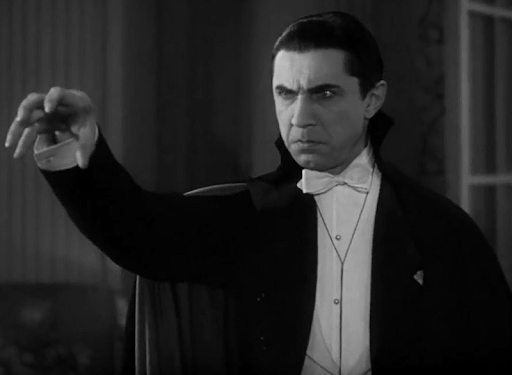Source: Wikipedia
As October 31st approaches, and with it the nationally popular holiday Halloween, many are seeking out their favorite works of horror cinema in celebration of this spooky season. Many of these films have long been revered as classic staples of the genre, such as Alfred Hitchcock’s 1960 film “Psycho” and George Romero’s “Night of the Living Dead” from 1968, while others, such as Paramount’s sleeper hit “Smile”, have only just recently been released and could very easily become a Halloween tradition in the coming years. Needless to say, the numbers of these kinds of films are seemingly endless and only growing larger with the passage of time. With that said, some characters tend to show up throughout the horror genre more than others, whether they’re the star of a long-running franchise (e.g. Michael Myers of the “Halloween” series, of which its latest entry, “Halloween Ends”, premiered just a few weeks ago) or are part of the public domain and can be freely used by any filmmaker (such as the Phantom of the Opera, whose filmography ranges as far back as the early 1920s). As far as the latter kind is concerned, few cinematic monsters have left quite as much of an impact as the nefarious Count Dracula. Since his introduction in Bram Stoker’s 1897 novel “Dracula” (with this year marking its 125th anniversary), the villainous bloodsucker has long been seen as the definitive fictional vampire, and the wide array of films he has appeared in (albeit sometimes under a different alias) is further proof of his longevity.
Interestingly, the oldest surviving film to adapt Bram Stoker’s story is one that does not use any of the names featured throughout, although the general plot and characters remain unchanged nonetheless. That film was released in 1922 under the name “Nosferatu”, made in Germany under the direction of F.W. Murnau and starring Max Schreck as a creature of the night referred to not as Dracula, but Count Orlock. This alteration of the names was an effort to get past copyright laws after Murnau was refused the rights for a more direct adaptation, though that didn’t prevent the Stoker estate from filing suit soon after the film’s premiere. Efforts were made to destroy all existing prints of the film, but some fortunately survived and enabled the film to live on to this very day. In fact, “Nosferatu” is regarded by many as a masterpiece of the silent era of cinema, with great praise going to Shreck’s performance as the menacing vampire antagonist and cinematography that relied heavily on the German Expressionist style that another silent horror, 1920’s “The Cabinet of Dr. Caligari”, had innovated just a few years prior.
It would be less than a decade later when Hollywood’s very own Universal Studios, having succeeded in acquiring the film rights to the original “Dracula” novel, attempted to create its own cinematic version of the titular vampire, and to say they succeeded would be something of an understatement. Although the film would more closely follow the 1924 stage adaptation of the novel more than the novel itself, few people at the time took issue with its deviations from the primary source material, too entranced and terrified by what was being shown on screen to think of anything else. Directed by Tod Browning, the film incorporated a slow and moody atmosphere to highlight the gothic nature of its many haunting set pieces, with the very first scenes showcasing Dracula’s Transylvanian castle being perfect examples of the haunting imagery shown throughout the film. Still, few would argue that anything featured in the film stands out nearly as well as actor Bela Lugosi as the titular character, with his thick native Hungarian accent and overall sophisticated charisma elevating the character from merely a horrific murderer to a person far more fascinating. A critical and commercial success upon release, “Dracula” has since been seen as one of Universal’s most famous monsters and appeared in several more films made by the studio, with Lugosi even reprising his role for the 1948 horror comedy “Abbott and Costello Meet Frankenstein”.
Browning’s film was not the only “Dracula” being made at Universal Studios at the time though, as another crew of filmmakers was actually making more or less the exact same film during the hours in which Browning and his crew were resting, using the exact same sets but having its actors speak Spanish instead of English. That film, also titled “Dracula”, was directed by George Medford (who allegedly did not speak Spanish himself and had to rely on a translator to give directions) and features actor Carlos Villarías as the titular count. Although the film was thought to be lost for some time after its premiere, one of its remaining prints was discovered in the 1970s and since been restored and made available for viewing, with many citing this Spanish-language version of the film as being superior to the original English-language version (though many still debate about whether or not Villarías’ performances matches that of Lugosi).
As the decades progressed, more cinematic versions of Dracula began to appear from time to time. Christopher Lee took on the role in 1958 for Terence Fisher’s British-made film “Dracula” (retitled as “Horror of Dracula” in the United States to avoid confusion with the 1931 film) and its subsequent sequels, most of which also depicted Dracula as having black, slicked-back hair and incorporated a visual style that relied heavily on black and a bright, saturated red for its overall color scheme. Going even further to give Stoker’s tale a greater amount of visual extravagance was Francis Ford Coppola of “The Godfather” fame with his 1992 film “Bram Stoker’s Dracula”, which (as the title suggests) aimed to be more faithful to its source material and utilize an appropriately faithful aesthetic to its production and costume design. Such efforts paid off well for the film, as it later won three Academy Awards, with one, for example, going to Eiko Ishioka for Best Costume Design.
In recent years, Dracula is perhaps best known as a more comedic character, brought to life as an animated character portrayed by Adam Sandler and Brian Hull in Sony’s “Hotel Transylvania” franchise. Universal has also made several attempts to revive its version of the character, most recently with the critical and financial disappointment “Dracula Untold”. As one can see, Dracula has appeared quite frequently over the course of cinematic history in many different forms (some more threatening than others), and it’s a testament to how strong this character is that he can he depicted in such drastically different manners yet still be very distinctly the vampire modern popular culture knows so well.




